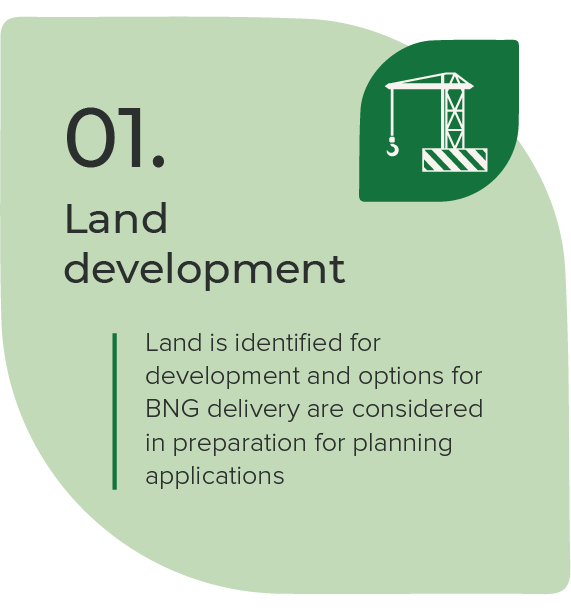
What is Biodiversity Net Gain?
This resource page answers common questions asked by local planning authorities, developers and landowners.
Please also explore the rest of the website, including our blog, for further advice. Our environmental and property consultants are also happy to answer any further questions, get in touch.
-
This biodiversity net gain resource page answers common questions asked by local planning authorities, developers and landowners about the scheme. Please also explore the rest of the website, including our blog, for further advice. Our environmental and property consultants are also happy to answer any further questions. Get in touch to ask us your questions.
-
Biodiversity net gain (BNG) refers to an approach to property development that leaves biodiversity in a measurably better state than it was before any construction work took place.
-
The Environment Act 2021 received Royal Assent in November 2021. This Act of Parliament requires all new developments in England to provide a minimum 10% net gain in biodiversity. It is anticipated that the requirement to increase biodiversity will come into effect in February of 2024.
The Environment Act will go a long way towards halting and even reversing this tragic decline in biodiversity in England by ensuring that the issue becomes a primary focus for property developers nationwide.
-
Onsite BNG means meeting the new requirements and introducing the 10% biodiversity net gain at the same site as a development takes place. This is the preferred solution, but it is not always viable without losing developable area, therefore mitigating against this biodiversity loss is possible offsite. Biofarm’s offering provides the full service to ensure that the net gain offsite is achieved. It is important to note that offsite land should be as close to the development site as possible, preferably within the same Local Authority.
-
From an ecological perspective, offsite is better. The types of habitats and species generated onsite tend to be very heavily weighted towards species that thrive in proximity to human activity. Working offsite – and preferably linking up several biodiversity sites into larger sites – means a greater diversity of species can thrive.
-
The biodiversity metric system was developed by The Department for Environment, Food and Rural Affairs (DEFRA) to measure the delivery of mandatory BNG for new developments in England. The metric tool scores different habitat types based on their relative value to wildlife. It also calculates and measures biodiversity losses and gains for developments.
Biodiversity Metric .0 only included three components: habitat diversity, species diversity, and ecosystem services.
Biodiversity Metric 4.0, on the other hand, includes four components: habitat quality, habitat connectivity, species diversity, and ecosystem services. The addition of habitat quality and habitat connectivity allows for a more complete assessment of the conditions required for biodiversity to thrive.
The Statutory Metric goes even further, with tweaks to the way watercourses and hedgerows are calculated, along with amendments to condition assessments and area modules.
-
A Habitat Unit is a parcel of land that is used to create an uplift in biodiversity. A unit is usually created on land of low productivity which can be converted to species-rich grassland, woodland, wetland, mixed scrub or rewilding sites. The numerical value of a Habitat Unit is based on its type, distinctiveness, condition and location.
-
Conversion of low-value habitats to higher-value ones typically generates between 1-3 Habitat Units per acre.
-
The gross value of each unit can vary from £20,000 - £60,000, depending on the complexity of creating and managing the habitat required. This range is based on the application of the DEFRA biodiversity metric, costings for habitat creation, and estimates for management, monitoring and maintenance costs.
-
The deal offered to landowners by Biofarm is the most competitive on the market. Biofarm sells the Habitat Units to developers who need to meet the BNG requirements. Landowners receive the full agricultural value of their land and a share of the net profit generated by the sale of the Habitat Units. Both payments are made immediately on the sale of the Habitat Units.
-
We’ve mapped out what a typical service from Biofarm looks like. As you can see, we help you at each stage of the journey. This includes everything from calculating your requirement to liaising with your local planning authority and handling all management and liability of your offsite habitat.
Client instruction
• Pre-planning ecological forecasting.
• Review and/or assistance with calculating BNG requirement.
• BNG costing and planning timeline established.
Purchase agreement
• Purchase agreement signed and 10% refundable deposit payable. (The deposit is returned in the event that planning permission is not granted.)
• Biofarm sources BNG habitat units (HUs) from inventory (available immediately) or via direct contact with the landowner network (six-month lead time).
Habitat strategy
• Habitat strategy and management plan agreed and submitted.
• Liaise with LPA and client to ensure BNG obligations met, including certification and delivery mechanism.
• Planning application submitted.
Planning approval
• HUs purchased on grant of planning permission.
• S106/conservation covenant agreement between LPA and Biofarm / landowner signed.
Habitat creation
• Habitats created as per planning requirement.
• Timeframe dependent on habitat type.
• Long-term management, monitoring and reporting strategy agreed with client.
Management and monitoring
• 30-year management and monitoring plan implemented.
• Continued oversight with regular client reporting, AI mapping and monitoring, and client site visits as required.
FAQ’s

Want more information? Let’s talk
We are a team of ecologists, environmentalists and planning experts with a wealth of knowledge on BNG. We’d be delighted to answer your query.







